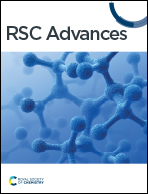Quantitative study of impact damage on yellow peaches based on reflectance, absorbance and Kubelka–Munk spectral data†
Abstract
Impact damage is one of the main forms of damage during the postharvest transportation and processing of yellow peaches. Thus, a quantitative prediction of the impact damage degree of yellow peaches is significant for their postharvest grading. In the present study, mechanical parameters such as the damage area, absorbed energy and maximum force were obtained based on a single pendulum collision device and an intelligent data acquisition system. The reflection spectra (R) of the damaged areas of yellow peaches were collected by a hyperspectral imaging system and transformed into absorbance (A) spectra and Kubelka–Munk (K–M) spectra. The R, A and K–M spectra were preprocessed by standard normal variables (SNV), moving average (MA) and Gaussian filtering (GF). Partial least squares regression (PLSR) models and support vector regression (SVR) models based on original and preprocessed spectra were established, respectively. By comparative analysis, the spectral data with better prediction performance (raw or preprocessed spectra) were selected from all spectra, and the characteristic wavelengths were selected by competitive adaptive reweighted sampling (CARS) and uninformative variable elimination (UVE). The PLSR and SVR models based on characteristic wavelengths were established. The results revealed that the prediction performance of the K–M-GF-CARS-PLSR model is the best. For the damage area, absorbed energy and maximum force, the RP2 and RMSEP of the K–M-GF-CARS-PLSR model were 0.870 and 77.865 mm2, 0.772 and 1.065 J, 0.895 and 47.996 N, respectively. Furthermore, the values of their RPD were 2.700, 1.768 and 3.050, respectively. The characteristic wavelengths of the model were 18.8%, 10.2% and 21.6%, respectively. The results of this study showed that there was a strong correlation between the mechanical parameters and K–M spectrum, which demonstrates the feasibility of quantitatively predicting the damage degree of yellow peaches based on the K–M spectrum. Therefore, the results of this work not only provide theoretical guidance for the postharvest grading of fruits, but also enrich the theoretical system of biomechanics.



 Please wait while we load your content...
Please wait while we load your content...